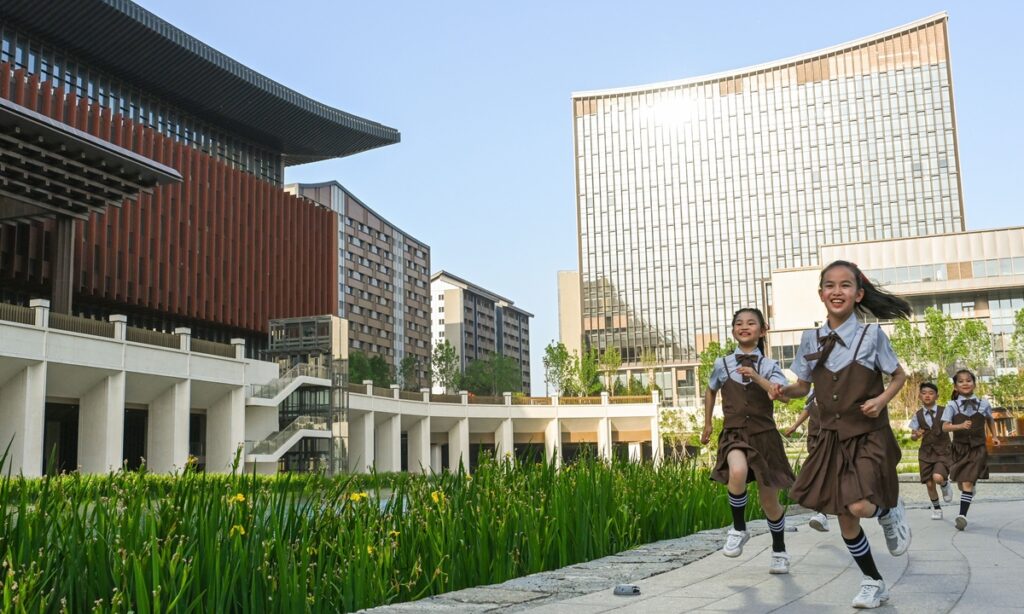The Political Bureau of the Communist Party of China (CPC) Central Commit-tee held a meeting on Friday to review a raft of guidelines on policies support-ing the construction of Xiong’an New Area in North China’s Hebei Province. The meeting, presided by Xi Jinping, general secretary of the CPC Central Committee, stressed the importance of creating “Xiong’an quality” and the site’s forward-looking urban construction design, which is tasked with the country’s exploration of a new model of modern city governance with Chinese characteristics.
On the same day, China’s State Council, the country’s cabinet, approved the establishment of the Xiong’an Comprehensive Free Trade Zone. Observers said the concrete moves signaled that the construction of the area — dubbed “the city of the future” — has entered a new stage of ramping up, with the gradual completion of industrial and strategic policy layout set to offer a further boost to its innovation-driven, green, open development.
As the work focus of the area has shifted from massive construction to a “triple emphasis on high-quality construction, management and development” stage, foreign officials and industry insiders have been breathlessly updating details on the national project of millennial significance, looking for valuable experience in the Chinese way of modernization.
Observers expected the coordinated development of the Beijing-Tianjin-Hebei region, facilitated by the area, to also provide unique wisdom for the development pattern of metropolises in Asia and elsewhere around the world.
According to the Xinhua News Agency, the formulation of the batch of policies carries significance in terms of transferring Beijing’s non-capital functions to the Xiong’an New Area, its massive construction and development, as well as its high-standard and high-quality construction.
The meeting identifies several priorities in construction, including pushing for ecological, green, and low-carbon development, strengthening tech innovation, and developing high-end and high-tech industry. It also calls for focus on city governing structure and public service systems, so as to “actively explore new models of modern city governance with Chinese characteristics.”
“The supportive policies are like an igniter, which is set to fast-track the development of Xiong’an in the next new phase,” Tian Yun, an independent macro analyst, told the Global Times on Friday. Observers hailed the area as epitomizing the Chinese way of modernization in all aspects that is green, low-carbon, innovative, open and sharing, and of common prosperity for all.
Ye Tanglin, a city planning expert with the Capital University of Economics and Business, told the Global Times that “Xiong’an is a sample of China’s modernization, and the sample is people-oriented.”
In early May, the top Chinese leader said during an inspection of Xiong’an that the area’s construction has achieved important results, and the top-level construction and development plan has been basically completed, after the “dream city” just celebrated the sixth anniversary of its establishment.
According to Tian, the key focus in the next stage is improving accompanying industrial policies – based on the top design – to draw in more high-tech, ser-vices enterprises, and to foster a high-end industrial cluster in the long term.
The establishment of the Comprehensive Free Trade Zone is regarded as a fresh policy effort.
The zone is located inside the China (Hebei) Free Trade Pilot Zone’s Xiong’an district, with an area of 0.63 square kilometers, state broadcaster China Central Television (CCTV) reported on Friday. The first phase has an area of 0.42 square kilometers, and contains seven function areas including customs’ accompanying support, cross-border e-commerce, and bonded logistics.
“The Comprehensive Free Trade Zone is the highest customs special supervi-sion zone in terms of openness. It also has the most preferential policies, most complete functions and most convenient customs clearing,” an official in charge of the management committee of the Xiong’an Free Trade Pilot Zone was quoted as saying in the report. The area is envisioned to be a national sample for Comprehensive Free Trade Zone development.
Tian said the zone’s establishment is a strategic move to promote “a big stride” in the development of Xiong’an.
“It provides accompanying services for certain Beijing-based centrally administrated state-owned enterprises that have plans or have already moved certain businesses to the area. It is also expected to attract a number of Beijing services trading companies,” Tian explained.
On Wednesday, Vietnamese Prime Minister Pham Minh Chinh also visited Xiong’an New Area, becoming one of the first foreign officials to tour the pio-neering area. Pham said the successful construction offers valuable experience for Vietnam, and stressed that his country will earnestly learn from its planning and construction experience, according to media reports.
Observers said that the construction of Xiong’an is inspiring for global metropolises like the Vietnam’s capital city Hanoi, some of which have either seen divergences between city construction and explosive population growth, or overwhelming city functions that have strangled the development room for neighboring areas.
In April 2017, China announced the establishment of the Xiong’an New Area, located about 100 kilometers southwest of Beijing, as part of measures to ad-vance the coordinated development of the Beijing-Tianjin-Hebei region.
(Global Times)




